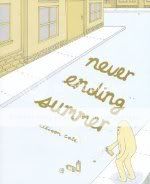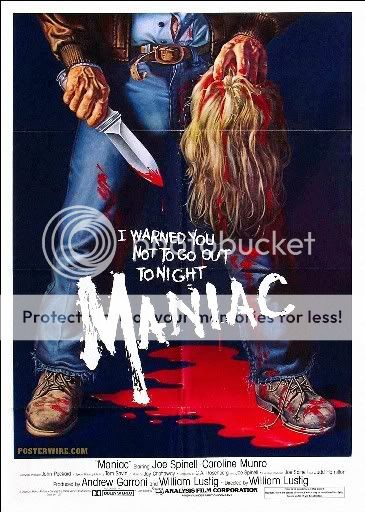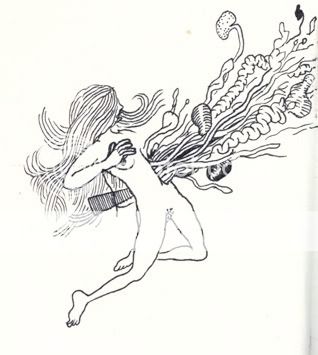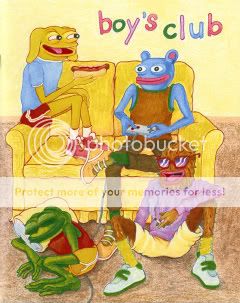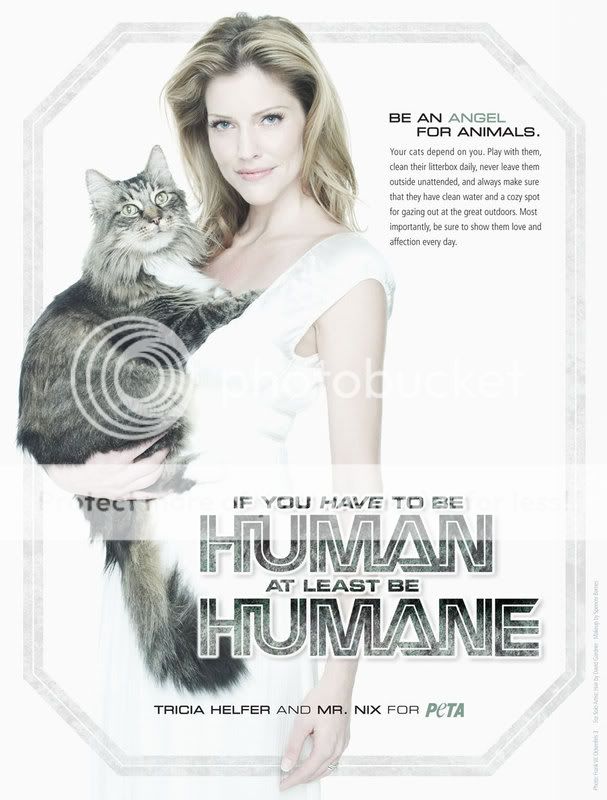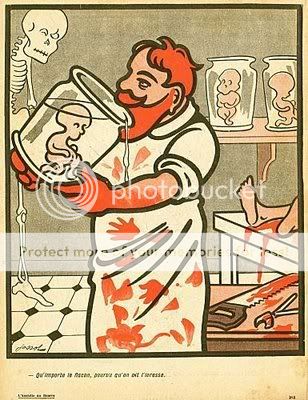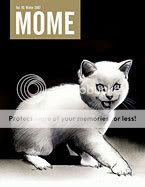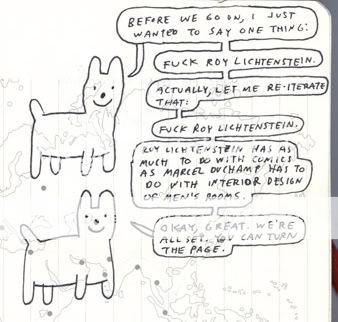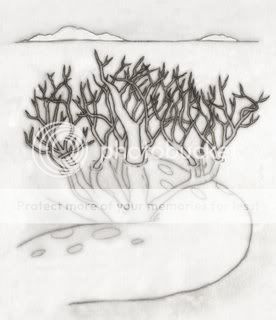I saw Iron Man and it was a lot of fun.
Carnival of souls
* Sounds like up to three made-for-TV Battlestar Galactica movies (in addition to the 2-hour Caprica pilot) may be in the works. The Chicago Tribune‘s Maureen Ryan says they’ll get made this summer if they’re greenlit, leading AICN’s Hercules to speculate that they’d be prequels to the final half of season four, a la Razor.
* The penultimate Horror Roundtable is up, and it’s about horror works that changed the genre. As our gracious host Steven Wintle puts it, “Ninety-nine weeks of Roundtables; ninety-nine weeks of Sean struggling with the topic and/or answering Hellraiser.” Which one is it this time, dear readers? The answer may surprise you!
* Here’s the red-band trailer for M. Night Shyamalan’s The Happening. It spoils some of the ways in which the people who are dying actually die, so be warned. Suffice it to say that the movie looks like it’s gonna earn its R rating. (Via Vault of Horror.)
* Water monsters in the news: Scientists in New Zealand have discovered a new species of jellyfish…already living in an aquarium! (Via Cryptomundo.)
* Finally, The House Next Door’s Sheila O’Malley on the genius of Jeff Bridges in The Big Lebowski:
It came to Jeff Bridges in a flash: “I must wear jellies when I play The Dude.” I cannot imagine why, I do not know why he made this choice, or where it comes from… who can say where genius lies? All I know is that every time I see that movie, and I watch him galumphing across a parking lot, jellies flapping on the pavement, I know that it is deeply right. It seems so right that it feels as though it must have been a conscious choice from a wardrobe department, or somehow imposed from above. But no. Jeff Bridges thought: “Jellies. I must wear jellies.” And this is why he is my favorite actor.
Carnival of souls
* Said it once before but it bears repeating: Matt Wiegle and I have a new comic that’s part of Top Shelf’s new webcomics launch Top Shelf 2.0. It’s called “The Real Killers Are Still Out There.”
* While we’re on that subject, I suppose I should say that I’m looking for artists with whom to collaborate on some additional strips. My email’s to the left if you’re interested.
* A woman in Croatia sat dead in front of the TV in her unopened apartment for 42 years after she was reported missing. In thinking about this story and the Stitzl incest case in Austria, it strikes me that the notion that people can go “missing” for decades while being right there among us is particularly horrifying, perhaps because of the way it implicates the rest of us for our failure to find the disappeared. (Via Jim Treacher.)
* Mary Elizabeth Winstead has been cast as Ramona Flowers in Edgar Wright’s upcoming adaptation of Bryan Lee O’Malley’s Scott Pilgrim series. Her saying “he likes to watch me pee” in the second half of Death Proof was easily my favorite thing from that segment of that film.
* Young John Stanley turns out to have been a bit of a hot piece of ass.
* I had forgotten all about the Nintendo game Super Dodgeball until Topless Robot pointed me in the direction of this free downloadable album of remixes and reinterpretations of the game’s multi-ethnic music. You could throw the dodgeball so hard it killed people, man!
* Finally, your video of the day is “Doot Doot” by Freur. Even back then, the future Underworld had something, and I don’t just mean “Brian Eno’s wardrobe.” Listen to how effortlessly it glides into “epic.”
New!
Today Top Shelf launched its new webcomics initiative Top Shelf 2.0, and among the strips they posted is a collaboration between myself and Matt Wiegle entitled “The Real Killers Are Still Out There.” I hope you enjoy it.
Comics time: Never Ending Summer
Never Ending Summer
Allison Cole, writer/artist
Alternative Comics, April 2004
96 pages
$11.95
Originally written on July 25, 2004 for publication in The Comics Journal
Never Ending Summer blazes no new trails. In fact, what trails it treads are familiar almost to the point of predictability: I think that by now we’ve all read enough auotbio comics to know that young, hip people drink cheap beer, complain about their jobs, obsess over their relationships, fetishize vinyl records, make mix tapes, and make out. If adolescent power fantasies are this medium’s overheated yin, post-adolescent disempowered realities such as this are its underheated yang.
But there’s a lot to be said for charm, and that’s why there’s a lot to be said for the very charming Never Ending Summer. The story, such as it is, follows author Allison Cole through a summer of minor upheavals in Providence, Rhode Island. Allison wakes up one day at the beginning of June with an enormous injury of an unspecified nature upon her lip. “So this is how summer begins,” she thinks as a friend drives her to the hospital in another friend’s borrowed car. It’s a fitting beginning to the story as it introduces several prominent themes: The power of Cole’s minimalist cartooning (her nightmare image of the injury consuming her entire face works perfectly), the unexpected difficulties that beset her throughout the season, and the support and succor she gains from her community of friends.
Cole’s debut graphic novel finds her confident in her use of her unique vocabulary of character, which is to say she draws adorable little people who look sort of like the ghosts from Pac-Man, but with arms and legs. Each is given a unique adornment for distinguishability–a ponytail here, an ironic moustache there, Descendents-style eyeglasses everywhere–and while that trick doesn’t always work, what does is the simultaneous sense of universality and idiosyncrasy the overall device lends to the characters and the story. It’s a lot harder to get tired of the misadventures of hipsters who hang out in kitschy dive bars when they look like stuffed animals. (It’s also interesting to compare this technique to the almost manic self-scrutiny of a Jeffrey Brown, say. Where Brown makes his seemingly uneventful autobio stories work through the intense navel-gazing reflected in his restless, sketchy inks, Cole takes the opposite tack and breaks the action down to a bare minimum of lines on a page. In the former, the reader is moved along by the sweaty work of the artist; in the latter, the artist encourages the reader to move the breezy work along.)
The clear influence overall is John Porcellino. Cole does not have the minicomics god’s assuredness of line, nor the ability to pull off the transcendental moments of liberation that marked Porcellino’s similar autobio novel Perfect Example. I was actually all the way through such a moment in Never Ending Summer before I realized, “hey, that was the big climax, wasn’t it?” But Cole’s learned that simplicity suits a simple story, There’s never a moment that feels forced, pretentious, or overblown, and the quiet moments are quiet without being maudlin or tedious. Some of my favorite images are simply Allison kneeling on her roof next to her chimney, or curled up with her cat. Clearly these are some of Cole’s favorite images, too.
Cole’s piece in Kramer’s Ergot 4 was a bit of inspired comedy, terrifically lampooning the oh-so-sensitivity of emo boys by casting them as the world’s wimpiest pirates; I’d have liked to see more of that wit in use here. I’m also not sure that the ending is earned by the events that come before: The idea is that Allison’s newfound creative outlet as a DJ enables her to be happy with and by herself rather than fixate on emotionally unavailable men, but wasn’t she already a cartoonist? Perhaps the nature of her cartooning–writing about her fixation on emotionally unavailable men–precludes that kind of fulfillment. Makin’ people boogie is probably a much better way to forget about that sort of thing. But unwittingly she’s done that here, crafting a delightful book that I’ll happily read again. It’s a promising start until she begins blazing trails of her own.
Carnival of souls
* One thing I meant to call out in particular from David Bordwell’s excellent essay on criticism yesterday but didn’t was this passage on “reflectionism”:
Reviews seldom indulge in analysis, which typically consumes a lot of space and might give away too much. Nor do reviewers usually float interpretations, but when they do, the most common tactic is reflectionism. A current film is read in relation to the mood of the moment, a current political controversy, or a broader Zeitgeist. A cynic might say that this is a handy way to make a film seem important and relevant, while offering a ready-made way to fill a column. Reviewers don’t have a monopoly on reflectionism, though. It’s present in the essayistic think-piece and in academic criticism too.
To this he appends a footnote:
Reflectionist interpretation usually seems to me unpersuasive, for reasons I’ve discussed in Poetics of Cinema, pp. 30-32. I realize that I’m tilting at windmills. Reflectionism will be with us forever.
Besides giving me something to add to my reading list, Bordwell has gifted me here with a term for the lamentable fixation of mainstream reviewers on sociopolitical allegory, real or imagined, in genre films generally and horror films specifically. As Bordwell implies, this tendency is by no means limited to genre and may or may not be a worthwhile line of inquiry.
* EW’s fanboy-writ-large Doc Jensen takes a look at 17 unsolved mysteries from Lost. I’m glad he called out the fatuity of the show’s creators’ half-assed treatment of the mysterious Numbers, because he actually has their ear. Dropped ball on “Adam and Eve,” though. (Via Whitney Matheson.)
* Because the only thing cooler than water monsters is water monsters from subterranean bodies of water, based on the plot description in this piece about how the guy who designed the Cloverfield monsters is working on the movie, I am now looking forward to the remake of Piranha.
* In an earlier, Spoiler Warning-free iteration of this post, Matthew Perpetua took the liberty of revealing to me the secret of M. Night Shyamalan’s upcoming film The Happening, goddammit.
* Speaking of Shyamalan, Not Coming to a Theater Near You’s Leo Goldsmith takes a look at the director’s underrated superhero thriller Unbreakable. Ah, that opening train-crash sequence shot. Long-take heaven.
* Dave at Rue Morgue posts the poster for Maniac. They don’t make ’em like this anymore.
* This parody video centering on a deluxe Tokyo hotel that doubles as a giant robot makes good use of uncanny immensity, something that all parody videos should probably do. (Via Topless Robot.)
* Your video of the day is “Let Me Go” by Heaven 17. The whole first two thirds is an redolent with the promise of the final third (you can’t miss when it kicks off)–it’s one of the most brilliantly structured pop songs I’ve ever heard.
* Finally, in the vein of my months-long project of Netflixing The Wire and watching it during my lunchbreaks, I’ve lately been doing the same with Deadwood. So far it makes The Wire look like CSI Miami, but the real reason I bring it up is because last night I had a sex dream about Calamity Jane and I don’t know how to feel about this. (I should note that this dream began with me being engaged to Gene Hackman’s daughter, who I barely knew and whose name I couldn’t even remember, and ended with me locking my father and uncles into a room, then holding the door shut while I listened in horror as they succumbed to the zombie bites they’d incurred earlier, tormenting myself by trying to discern who was the last to turn and therefore the first victim of the other two. It made the Jane-sex seem a lot less uncomfortable in retrospect.)
Carnival of souls
* Sean T. Collins in the news! I’m one of the creators mentioned in Publishers Weekly’s piece on Top Shelf’s new webcomics initiative, Top Shelf 2.0. Look for some new comics written by me and drawn by Matt Wiegle and Matt Rota in the near future.
* Sean T. Collins in the news again! Well, kinda: Tom Spurgeon has posted my response to his recent essay bemoaning the high cost of pamphlet-format comic books. I didn’t find a lot to disagree with, let’s say.
* Sean T. Collins in the news but he forgot! Because I am a terrible self-promoter I neglected to mention that I’ve had several pieces in Maxim over the past couple of months. In the issue currently on stands (with Elisha Cuthbert on the cover) I co-wrote the features on 300 Movies to See Before You Die and Superhero B-Listers. And in the previous issue (with Mischa Barton on the cover) I wrote pieces on the deluxe edition of Alan Moore & Brian Bolland’s Batman: The Killing Joke and the new season of Battlestar Galactica featuring a mini-interview with Katee Sackhoff. I hope you enjoy(ed) them.
* Spurred on in part by the great Matthew Zoller Seitz’s retirement from film criticism and the latest round of firings and buyouts among newspaper and magazine critics, film scholar David Bordwell has put together a feast of a post on the enterprise of film criticism–what criticism is, different components of it and approaches to it, the difference between taste and judgment, the difference between criticism and reviews (it’s mostly that the latter’s a subset of the former, but I’ll let him explain), the criteria we use when we write criticism, and a call for a different type of criticism on the web. If you write criticism or read a lot of it, it’s a must-read.
* The big news of the week for the refined superhero nerd is the launch of Douglas Wolk’s Final Crisis Annotations blog, an attempt to do for the upcoming DC mega-event and its direct tie-ins what Wolk previously did, entertainingly, for the weekly series 52 with his 52 Pickup blog. I wish he’d include Final Crisis writer Grant Morrison’s indirect FC tie-in “Batman: R.I.P.,” but you can’t always get what you want, as the fella says.
* Speaking of Final Crisis, here’s design god and comics nerd Chip Kidd on his designs for series’ covers, which I’m really quite fond of so far. (Via Tom Spurgeon.)
* In less stellar design news, Dave at Rue Morgue gives the business to some stupid art choices for The Mist‘s Korean-theatrical and American DVD releases.
* It would be difficult to overstate the impact that the classic man vs. nature adventure/horror/seige story “Leiningen versus the Ants” had on my young imagination, so it would also therefore be difficult to overstate how awesome I found this story on rampaging ants overwhelming Houston and potentally destroying its electronic infrastructure to be. (Via Drudge.)
* My Topless Robot compadre Jackson Alpern sticks it to the Top 10 Brutally Annoying Comic Relief Characters. As he himself points out, since Jar-Jar Binks isn’t number one, you know you wanna read it. Jackson also gets huge points for likening Snarf from Thundercats to a Jewish mother and his use of the phrase “fucking suckitude,” points only slightly mitigated by his inexplicable enthusiasm for The Fifth Element. (It’s a silly movie with a terrible plot (“Love is the fifth element!”) and terrible acting and pretty visuals, and since everyone involved is condescending to the genre rather than embracing it, they think that’s good enough. It isn’t!)
* I found this Matthew Perpetua post on the perils of scenesterism and “community” quite sharp. As I think I used to talk about on here years ago, I’ve come to view my relatively isolated existence in the suburbs of Long Island as a real saving grace given how easy it is to lapse into mindless boosterism when surrounded by likeminded artsy-fartsy types. Then again, maybe I’d have gotten more work done if I were surrounded by people telling me how great I am.
* Finally, your video for the day is “But Not Tonight” by Depeche Mode. What I like about it is not just its glimpse of Dave Gahan during his transitional period from gawky, enthusiastic teenage New Waver to brooding synth-goth hunk, but its incorporation of snatches of the forgotten ’80s urban-romance-drama (I assume) Modern Girls, the soundtrack for which included this song. I don’t know anything about the movie beyond recognizing the cast and inference from the snippets, but it all goes toward what I now find so compelling about ’80s synth-pop, or at least what I get out of it: an utterly unironic sense of importance about how your heart feels right now. The pristine production roots every note in the moment and the earnestly Romantic lyrics convey a life in which the thought of tomorrow is impossible.
Comics Time: Batman #664-669, 672-675
Batman #664-669, 672-675
Grant Morrison, writer
Andy Kubert, J.H. Williams III, Tony Daniel, Ryan Benjamin, artists
DC Comics, April 2007-April 2008 or so
22 pages each
$2.99 each
Grant Morrison is my favorite superhero comics writer, one of the very few writers in comics I’ll read anything by. Batman is my favorite superhero, the only character I feel an attachment to as an entity rather than as a character in a story that may or may not be good by artists and writers who may or may not be good. Put Morrison and Batman together and you should have a recipe for Sean T. Collins Nirvana, but for some reason that hasn’t been the case. What I seem to recall being the standard Kubert Bros.-related scheduling difficulties early on; Morrison working in a deliberately choppy, almost disjointed narrative style both within individual issues and from issue to issue and short arc to short arc; sketchy, sloppy art from Kubert and unremarkable ’90s-style art from Daniel and Benjamin jarringly interrupted by a bona-fide star turn from the great J.H. Williams III; that awkwardly inserted Ra’s al-Ghul-centric crossover with all the other Bat-titles; my job at Wizard coming to an end and with it my weekly free access to superhero comics…put it all together and you have a book tailor-made for me that I wasn’t even following.
I was recently loaned a more or less complete run of Morrison’s tenure on the title–sans the initial “Batman & Son” arc that introduced Batman and Talia al-Ghul’s enfant terrible son Damian and the issues pertaining to the Ra’s al-Ghul crossover in which the old villain attempts rebirth in the body of his grandson–and I was pleased to discover I liked the whole thing a lot.
Like so many of Morrison’s long runs it’s badly hampered by the art he’s saddled with, perhaps moreso here than in other cases since so much of Morrison’s staccato scripting depends on nuances of body language, facial expression, and mise en scène. Meanwhile, that pow-pow-pow pacing and those brief, three- or two- or even one-issue story arcs give the illusion of a lack of continuity within the run overall. But taken in one sitting these problems are easily smoothed over, and what reveals itself is a dual project.
First, and credit here goes to my friend Kiel Phegley for pointing this out, Morrison foregrounding Batman as the main point of interest in every story. Whereas normally the character plays a particularly badass brand of straightman to the more glamorous villains and horrifying murder-mysteries he’s up against, Morrison’s emphasis is on the hero himself, and on establishing him as every bit as weird, exciting, scary, and memorable as his antagonists. This is reflected in Morrison’s choice of antagonists itself: as with All Star Superman, he’s trotting out a parade of baddies who in one way or another serve as his flawed doppelgangers. The peak-human-specimen al-Ghul family, the crimefighting Batmen of Many Nations and their billionaire benefactor, three crazed Batman-impersonating policemen, even Bat-Mite–they all throw what makes Batman Batman into sharper relief via contrast, demonstrating that while he is indeed weird, exciting, scary, and memorable, he’s also a fundamentally good person who never loses sight of the values that matter to him and by which he’s chosen to define himself.
Second, Morrison is slowly advancing a novel and vastly more enjoyable take on the shopworn “shadowy villain manipulating things behind the scenes” mega-storyline in the person of the Black Glove, a figure of unknown provenance behind many of the story’s events. Morrison has basically avoided those annoying scenes where the shadowy figure literally appears as a figure in shadows once or twice per issue, making ominous statements and showing us just enough of his silhouette that we can start guessing whether he’s Mysterio or Hush or whoever. Instead, Batman arranges his recent cases into a pattern at the center of which is a hole in the shape of something that’s more of an idea rather than a person–a “king of crime” figure so brilliantly evil that even Batman had no idea he existed and had been pulling strings for nearly Batman’s entirely career. It’s all coming out in this kind of slow, unnerving fashion, more identifiable as something feeling weird about the stories rather than as a story element in and of itself. Hopefully the central revelation will be as satisfying as that of, say, New X-Men. At any rate, while I can see why people (myself included) may have gotten a bit lost in the shuffle, I’m now reading some of the book’s more oblique storytelling choices as just that–choices–rather than lapses, and I’m firmly back on board.
Carnival of souls
* The next volume of the seminal experimental comics anthology Kramers Ergot will be 16″ x 21″ and retail for $125 for 96 pages. A bargain at any price, most likely.
* Everyone knows about Sam Jackson’s Nick Fury cameo and Avengers name-drop at the end of Iron Man, but apparently Marvel is also subtly planting Captain America Easter eggs in both Iron Man (his shield) and The Incredible Hulk (the super-soldier serum). That’s a cute way to lay the groundwork without being annoying and confusing the squares.
* Jason Adams’s long-running love affair with Speed Racer came to an end after he actually saw the movie.
* Finally, your video of the day is “Smalltown Boy” by Bronski Beat.
Carnival of souls
* IRL mishegoss continues to interfere with my ability to see either Iron Man or Speed Racer, but apparently the former’s second-weekend performance obliterated the latter’s debut. We’re talking all-time, legendary, Cleopatra/Heaven’s Gate-level failure, not just in terms of the financials but the role that hubris played in the film in question’s creation (separating it from, say, The Adventures of Pluto Nash). My completely uninformed opinion is that this is probably a damn shame. Without seeing the movie I can’t know if this is an Ang Lee’s Hulk-style noble-failure arthouse-popcorn experiment gone bust or a work of sheer awesomeness that a mainstream critical consensus I’ve come to find increasingly irrelevant to my own experience can’t possibly appreciate, but because I am a misanthrope I’m leaning toward the latter. Anyway Jog reviewed the thing and I enjoyed it without even having seen the flick.
*LOST SPOILERS FOLLOW, SO IF YOU HAVEN’T SEEN THE LAST FEW EPISODES, PLEASE DON’T READ THE NEXT THREE PARAGRAPHS
On the “genre art I’ve actually seen” beat, I thought last week’s Lost was a good-but-not-great episode. It lacked the emotional heft that Alex’s matter-of-fact execution gave the previous mythology-centric ep a couple weeks back. However, it benefits from the return of two shaping-up-to-be-terrific villains in a show that’s seen its share. First, there’s so and so’s Keamy, the intensely amoral mercenary whose beady eyes and slightly sibilant speech make him seem like nothing so much as an insecure alpha-male lacrosse-team stud from high school gone overgrown and rancid. Then there’s Nestor Carbonell’s ageless Richard Alpert, whose beatific smile and seemingly kohl-lined eyes exude this warm, calm, almost androgynous handsomeness that nonetheless comes across as latently threatening and incredibly creepy. When they held on that close-up of him outside Baby Locke’s nursery I nearly lost my shit.
* If you’re interested in further discussion of last week’s episode you could do worse than to check out the following pair of links. First, E!’s Kristin Dos Santos does the Damon Lindelof/Carlton Cuse joint-interview thang. “Darlton,” as they’ve come to be known in the abbreviation-happy lingo of shippers (now there’s an untapped slashfic pairing–at least I hope it’s untapped), do their usual interview balancing act of recounting how the show’s now-set-in-stone scheduling and now-resolved writers’ strike impacted their storytelling; teasing sexytime secrets for the Skaters, Jaters, and Jackets among us; and addressing the Theory School of Lost Fandom by simultaneously fanning the flames and knocking down some castles made of sand.
* Second, I found this week’s “Best of the Lost comment thread” selection at Whitney Matheson’s Pop Candy a particularly enjoyable batch. Just for example, I had no idea of the origin of the little item-selection ritual Young John Locke is put through by Richard, while the notion that the Island is Atlantis (or at least the basis for the Atlantis legend) delights me to no end (and is about a billion times more plausible than your average Grand Unified Theory of Lost to boot).
END LOST STUFF SO NOW YOU CAN READ AGAIN
* Casting information for the Battlestar Galactica prequel pilot Caprica has been trickling out; three intriguing cast members I’ve seen are Eric Stoltz, Esai Morales, and Deadwood and Lost‘s Paula Malcolmson. (Via Whitney Matheson.)
* Go, look: More comics by Anders Nilsen!
* Your video of the day is “Vienna” by Ultravox.
* Finally, meet Patrick Batman. (Via Topless Robot.)
Comics Time: Boy’s Club
Boy’s Club
Matt Furie, writer/artist
Teenage Dinosaur, 2006
40 pages
$5
This is one of the funniest comic books I’ve ever read. The closest thing I can compare it to is the music of the cock-mock-rock band Electric Six; both take the absolute lamest aspects of rokkin’-out culture–bad drugs, bad booze, bad food, bad jobs, bad taste–and po’-facedly present them like features of that lifestyle rather than bugs. Instead of phony rock gods, the main characters of Boy’s Club are a quartet of ’80s-style funny-animal cool dudes with all the right moves, like a cross between Bill & Ted, the Tri-Lams, and the Teenage Mutant Ninja Turtles. Many of the funniest gags center on their cliché-heavy responses to absurd situations–lots of big grins and thumbs up, statements like “oh snap!” and “it’s a free country” and “peace out!”, words like “amigo” and “awesome,” and so on. Meanwhile, the visuals come across like a sitcom version of Paper Rad, frequently riffing on drug experiences to pull of non sequitur sight gags like one character’s face melting off or morphing into Falcor from The Neverending Story. The best jokes–and in this book, that means they’re pretty goddamn great–combine goofball visuals with that deadpan duuuude humor: a six-panel grid of reaction shots to a particularly huge hero sandwich, a character’s response to finding another character’s vomit in the bathroom sink. They’re kind of like Achewood if that strip were done by the guy your roommate bought pot from in college rather than a software designer. It’s the kind of comic you’ll stick in friends’ hands and force them to read it. If you like humor comics I really can’t recommend it highly enough.
Carnival of souls
* Lost‘s final two seasons will each be 17 hours long, to make up for the hours lost to the writers’ strike this season.
* Two of my favorite things, Battlestar Galactica and cat ownership, combine in Tricia Helfer’s PETA ad.
* Sign this petition to get godlike Universal Monsters make-up artist Jack Pierce a star on the Hollywood Walk of Fame. (Via B-Sol, who’s assembled a fantastic gallery of Pierce’s best work.)
* I was quite taken with Monster Brains’ assortment of art by early 20th-century French illustrator Gustave-Henri Abdul Karim Jossot.
* This week’s Horror Roundtable is about our favorite special effects sequence in a horror film. I personally stay in my (dis)comfort zone, but among the other responses a clear Greatest Of All Time emerges, and on that score I wouldn’t disagree.
Heil, Speed Racer, Heil!
There’s something about the ululating crowds who line the action in color-coordinated rows; the desperate skirting of ordinary feelings in favor of the trumped-up variety; the confidence in technology as a spectacle in itself; and, above all, the sense of master manipulators posing as champions of the little people. What does that remind you of? You could call it entertainment, and use it to wow your children for a couple of hours. To me, it felt like Pop fascism, and I would keep them well away.
—Anthony Lane, The New Yorker (via Jog)
Narrowing your eyes against the strobe effect, you make out three
movie stars: John Goodman, Susan Sarandon, and Christina Ricci,
cheering Speed on from the impossibly vast stands that rise up from
the racetrack (so vast they recall footage of Nazi rallies, but no
time to think about that now).
—Dana Stevens, Slate (hat tip: Matt Wiegle)
Spot any other critical comparisons of Speed Racer to the architects of the Holocaust? Post ’em in the comments!
Comics Time: Mome Vol. 10: Winter/Spring 2008
Mome Vol. 10: Winter/Spring 2008
Al Columbia, Sophie Crumb, Dash Shaw, Ray Fenwick, Émile Bravo, Jim Woodring, Robert Goodin, John Hankiewicz, Tom Kaczynski, Jeremy Eaton, Kurt Wolfgang, Paul Hornschemeier, Tim Hensley, writers/artists
Eric Reynolds & Gary Groth, editors
Fantagraphics, December 2007
120 pages
$14.95
Mome Vol. 10 by contributor, in order of appearance:
* Al Columbia’s gorgeous and frightening front cover is so great that I found myself trying to justify the “someone’s about to torture an animal” back cover image, where normally I’d just say “fuck that shit.”
* I really like the ink and watercolor portrait that is Sophie Crumb’s first contribution to this volume. Her comics, though, are more of the smug writing and unpleasant art that have put me off of her work in past volumes.
* Dash Shaw’s science-fiction story is my favorite thing by him I’ve seen so far. I feel like his lo-fi diagrammatic art and layouts are really clicking here, while the storyline’s central conceit of a man who comes from a world where time runs backwards is ambitiously complex and demands Shaw be inventive in solving the problems it presents him with visually. The use of color is measured and smart, and there’s a weird pathos to both the ideas and the way Shaw draws the characters. I could imagine Kevin Huizenga doing a wicked cover version of this strip.
* Ray Fenwick does his sublime/ridiculous prose/subject matter juxtaposition thing again and I don’t think it works all that well here. Celebreality gossip culture is a soft target.
* Émile Bravo does another sociopolitical pictographical parodical morality play involving various ethnicities’ views of those below their rung in the social hierarchy; it’s a sensible idea but not something that blows you away with its insight, and I think he undercuts it slightly with the punchline.
* In the conclusion to Jim Woodring’s “The Lute String,” Pupshaw and Pushpaw are punished by the elephant god for their transgressions by being sent to Earth Prime! It’s as much fun looking at Woodring’s art as it is seeing this pair of pranksters get their comeuppance, and meanwhile it’s really odd and funny to see Woodring draw normal people. That punchline panel is a scream.
* I really like the way Robert Goodin draws people, with big forearms reminiscent of Popeye and really unique facial designs. I’ve seen world-culture myths adapted before, of course, and this Indian shaggy-dog story doesn’t stand out all that much in terms of the moral imparted or the mechanics of getting there, except for that lovely art.
* John Hankiewicz’s debut Mome contribution is a doozy. The narrated story, a tale of a gentrifying neighborhood reminiscent of Tom Kaczynski’s contribution to Vol. 9, draws attention to Hankiewicz’s finely detailed environments and thus heightens the frisson of seeing three very different types of figures moved through it by the cartoonist: a fairly realistic representation of the narrator and (I think) his father; a giant-headed, Tweedle-Dee/Tweedle-Dum-esque couple whose out-of-scale-ness represents the gaily crass nouveau riche new inhabitants of the neighborhood–in one memorable panel, they appear totally and disconcertingly naked; and a thickly delineated, faceless abstraction of a female, symbolyzing the anonymous self-mutilator whose weblog or livejournal the narrator habitually visits. It’s this strip I’ll return to, no doubt.
* I was going to say something like “Tom Kaczynski returns to the familiar territory of industrial/commercial environments altering people’s internal landscape,” and then I thought how funny it is that a subject like that is familiar territory for someone. I’m grateful that’s the case even though I don’t think it’s all quite cohered to the level of power he hopes for yet. This one comes close, but for some reason I think it would have worked better if it were longer and had more time to build up to the ending.
* Jeremy Eaton’s art is text-heavy and really loose, Stieg-esque I suppose. I’m not 100% sold on his short-story-ish tale of a retarded man accused of a gruesome crime, and I’m not sure the limited scope of his layouts gives his loose line enough room to breathe and really have an impact, but I’d like to see more.
* This is my favorite chapter of Kurt Wolfgang’s “Nothing Eve” so far. It’s replete with insightful observations about crowd dynamics, and a funny (if slightly overwritten) wink at how Hollywood inflects our view of how momentous occasions are supposed to unfold.
* Paul Hornschemeier’s heroine gives her one-night-stand the kiss-off in this installment of “Life with Mr. Dangerous,” and I think the scene plays realistically and uncomfortably. But Amy’s affect is so flat and her reasons for being such a downer all the time so underexplored that it seems to me like it’ll be really hard for her to hold our interest as a main character in an eventual collection of this story; I found myself agreeing with her gossipy coworker’s harsh assessment of her even while I thought the coworker herself was a bit too one-dimensionally glib.
* The punchline panel for Tim Hensley’s sole Wally Gropius strip this volume continues the disturbingly violent undercurrent he kicked off with the Jillian/incest strip last ish, and also serves as a rejoinder to the callous Columbia image that follows on the back cover.
* As is the case with pretty much every volume of Mome, it’s tough to imagine a better value for your alternative comics-buying dollar. The range in tone, style, subject matter, and even quality makes it a uniquely bracing quarterly(ish) view of the state of the art.
Carnival of souls
* Go, look: The latest installment of Brian Ralph’s first-person post-apocalytptic thriller Daybreak!
* Go, look: New Anders Nilsen comics!
* Go, cover your eyes: That horrifying scene from Superman III where the big computer turns the lady into a robot and I ran screaming and crying from the room and couldn’t go near the TV for days because I was afraid it would somehow turn itself back on and show this scene again!
* My old college chum Sara Edward-Corbett, late of Partyka, is joining Mome!
Carnival of souls
* Five-page previews hit the Internet today for a pair of highly-anticipated-by-me Grant Morrison comics: DC mega-event Final Crisis and the “Batman: R.I.P.” storyline in Batman. The former comes complete with a sketchbook page of artist J.G. Jones’s interpretation of the villain Darkseid, while the latter boasts the best opening page ever:
* Apparently there’s some concern that Speed Racer will be a giant flop. Considering that that my uncle went to the world premiere a few days ago and told me how much he loved it (“a movie version of Mario Kart“) and a friend of mine emailed me yesterday about how great it was and I still didn’t realize it was coming out this weekend, this concern is probably warranted. Anyway, Jason at My New Plaid Pants brings this up because he didn’t like Iron Man (which I still haven’t seen) and can’t understand why that movie was so much more anticipated than Speed Racer. In a world run by Jason this would be different, but a billionaire playboy who builds a suit of armor and blows up terrorists with is probably just a bit more fundamentally appealing to most people than day-glo Christina Ricci outfits. (I say why choose?)
* I disagree with Jon Hastings about Batman Begins–real quick: directorial anonymity is not a virtue, there’s nothing “sophisticated” about the film’s absurd take on justice vs. revenge, and in terms of the Tim Burton Batman‘s supposed Joker weak spot, I think the difference between Nicholson as Jack Napier and Nicholson as the Joker is night and day–he goes from this slick buttoned-up sociopath to this wild, camp, let-it-all-hang-out grand guignol comedian. Plus all the praise Jon heaps on the Burton Batman in terms of its superior pacing, action choreography, design and so on is dead on. All that being said, his new post on visual poetry (or the lack thereof) in superhero films basically nails why I like the first Burton Batman so much and remain so unimpressed with, say, the Spider-Man movies (except for the third!): They’ve just got no panache! As Jon puts it, their action and spectacle is strictly in the summer-blockbuster idiom; take away the costumes and origins and they could easily be secret agents, pirates, archaeologists, soldiers, cops, space swashbucklers, whoever. The uniqueness of superhero comics’ native fantastical action is lost, with very few exceptions.
* Finally, for fans of irreverent summaries of Thor’s appeal as a character, I offer you this passage from Tom Spurgeon’s review of The Essential Thor Vol. 3:
The panels where Thor is not punching people so hard their light source changes are stuffed to the brim with either a) cool-looking Kirbyana almost always in the form of monsters and machinery, b) Volstagg, a fat coward who can bench press a bus, providing J. Wellington Wimpy-style comedy relief, or c) Thor screaming at someone about how awesome he is in preparation of punching them so hard their light source changes.
Comics Time: Mome Vol. 9: Fall 2007
Mome Vol. 9: Fall 2007
Ray Fenwick, Tim Hensley, Al Columbia, Eleanor Davis, Jim Woodring, Gabrielle Bell, Andrice Arp, Joe Kimball, Mike Scheer, Tom Kaczynski, Brian Evenson & Zak Sally, Kurt Wolfgang, Paul Hornschemeier, Sophie Crumb, writers/artists
Eric Reynolds & Gary Groth, editors
Fantagraphics, October 2007
120 pages
$14.95
Mome Vol. 9 by contributor, in order of appearance:
* Ray Fenwick’s text-heavy pin-up pages, drawn on the dismembered back covers of old hardcover books, mostly do that ironic combination of grandiose language and quotidian concerns, but for my money his best gags are the simplest. His “FUCK YOU AND YOUR BLOG” page, where that line of text is juxtaposed with a jauntily floating balloon, is a little easy but still made me think of scanning it and posting it on message boards; the conclusion of his first piece, which states that your estranged former best friend is “not available for comment,” hit me like a punch in the gut.
* Tim Hensley’s Wally Gropius strips have always been both funny and interesting to me in their absurdist, angular deconstruction of old Archie visual and narrative tropes, but I think this is the volume where they really made me sit up and take notice. The panel to panel physical business in the library-based strip “Shh!” is a delight to behold, and the incestuous conclusion to “Jillian in ‘The Argument'” is a note-perfect, savage lampoon of Sam-and-Diane-style “enemies become lovers” rom-com rhythms.
* Al Columbia can draw like a motherfucker but that’s really the only thing I got out of his Hansel & Gretel pastiche. Aside from the kiddie-killer’s creepy face it wasn’t really funny or scary.
* Eleanor Davis’s tale of two brothers and the abandoned house they discover in the woods reads like a cross between her usual monster-myth beat and the observational-drama family matters of her minicomic Mattie & Dodi. I’d probably still prefer the straight-up former to a combination of the two. However, Davis’s ambiguous treatment of what the brothers experience in the house and the casual fraternal violence of its aftermath is certainly unsettling.
* The first half of Jim Woodring’s “The Lute String” is a bonanza of adorably mischievous drawings of Pupshaw and Pushpaw, weird fungal creatures and transformations that gently trigger a phobia I have about growths, and a portrait of what God looks like in the world of Frank. (He’s an elephant!) Woodring comics are funny and scary and beautiful and look like Woodring comics and nothing else, which is a colossal achievement.
* I don’t get why Gabrielle Bell spots blacks the way she does. It clutters the image and distracts from the rhythm of the page.
* Andrice Arp does her own thing with another adaptation of a pre-Revolutionary War anti-English broadside. What’s interesting about these is how astutely they simulate what comics probably would have looked like had comics proper been around at that time, not just in terms of the character designs and typography but the metaphorical visual vocabulary itself–a haughty English captain vomiting his heavily taxed tea down the throats of helpless colonists, for example.
* Joe Kimball’s vertiginous page layouts and masterful graytones maintain the eerie air of his previous contribution to the series, but the comparatively straightforward visuals and storyline–involving an old man returning to his vampiric lover for one last embrace–reveal limitations in his figurework and storytelling.
* Mike Scheer’s art is indeed astonishingly lush given that it was created in ballpoint pen, but beyond that I don’t connect with it. I like the overly long titles he gives each piece, though.
* Tom Kaczynksi’s vaguely Ballardian tale of a young couple traumatized by the construction of a high-rise condo in their ersatz neighborhood is another of his capitalist cautionary tales, and like the earlier ones it somehow never feels didactic despite the potential for lecturing or hectoring. I think it might be because he is primarily concerned with the emotional impact of consumer society rather than the political, philosophical, or economic impact. The narration is just shy of hard-boiled, which is funny, and placing his story right after one of Bell’s makes for an interesting contrast in terms of how the two artists differ in their depictions of urban ennui–Kaczynski is colder and sharper, and while his characters lack the warmth of Bell’s his pages convey their information more dynamically and convincingly.
* Zak Sally’s adaptation of horror writer Brian Evenson’s shifting-identity body-horror story “Dread” is a case of designy typography overwhelming whatever power the story itself might have had.
* At this point Kurt Wolfgang’s Bagge-esque cartooning is almost as out of place in Mome visually as Sophie Crumb, and it’s not the kind of style I gravitate to naturally, but the fact that his story’s premise is “last night before the end of the world” is a hell of a way to keep you eagerly coming back in anticipation of the climax. With my luck nothing will happen.
* This is the most effective chapter of Paul Hornschemeier’s “Life with Mr. Dangerous” so far, and not just because of the nudity–I just really liked the panel where our heroine’s murmur of “I’m sorry” to her absent boyfriend is partially drowned out by her one-night-stand’s snores.
* Sophie Crumb…I don’t see the appeal.
Carnival of souls
* The same IRL issues that have prevented me from doing a lot of blogging over the past few days have also prevented me from seeing Iron Man, which I think makes me one of five people online who haven’t. So I can’t really speak to Jim Henley’s review of the film other than to say that Jim’s nerdblogging is always a treat and that this passage, about the much ballyhooed in nerd circles post-credits cameo by Samuel L. Jackson as Nick Fury, is quite applicable to similar moments in comic books that rely solely on costume recognition rather than inherent drama for impact:
Downey and Mister Cameo are both great big comics fans, and the irony of Mister Cameo performing in the role that was literally drawn for him is a huge pleasure, but as a scene it’s inert. They give each other nothing. There’s nothing there that you, the fan, haven’t brought yourself.
* Speaking of superhero movies, I thought Batman Begins was absolutely dreadful and I think Tim Burton’s Batman film costarring the Joker is the best superhero movie ever by a country mile, so I’ve had a really hard time mustering any enthusiasm for Christopher Nolan’s The Dark Knight. However, I did enjoy the new trailer, and not just because Heath Ledger’s Joker sounds a lot like David Lynch. (But it helped. I wouldn’t say “exactly,” though, Jason–let’s hear him pronounce “chihuahua” first.)
* Neil Marshall’s eminently enjoyable post-apocalyptic action flick Doomsday arrives on DVD July 29th. Note to self: pre-order a copy for Steven Wintle.
* There’s viral pictures of Cloverfield critters circulating around the Internet thanks to the already-underway campaign for Cloverfield 2. I am totally down with this as long as the focus remains on the monsters, which were excellent.
* This reminds me that I re-watched The Mist last week and found myself able to enjoy it more, since I knew what the problems were (Mrs. Carmody, the terrible CGI for the tentacles, a lack of genuine horror-scares, the awkwardly paced ending) and could basically brush them off and focus on the fact that it’s a movie about grotesque monsters killing and eating people trapped in a grocery store, one of the all-time great horror concepts. Focus on the monsters, that’s my motto.
* Kristin Thompson, big-time film scholar and (I still can’t get over this) LotR fangirl and author of The Frodo Franchise, rounds up recent rumors regarding production troubles on Peter Jackson’s adaptation of The Lovely Bones, most of which now stand debunked.
* In his latest update on the horrendous rape/incest/imprisonment saga of Josef Fritzl and family, Bryan Alexander engages in some amusing alternate-reality headline writing for a world in which the case somehow involved the Internet. That sort of thing is always instructive.
* Here’s a lovely, evocative drawing of some kind of water monster by the great Renee French. One of the things I find so powerful about water monsters is the way that depictions of them can play off size and depth so as to make not only the monster itself but its very environment a locus of horror, and that’s what this drawing does.
* Bruce Baugh points out something I’d really never considered about Hostel and its crappy sequel, namely that they never really explain how and why the torture ring came into existence. It’s a welcome lack of exposition, and I’m almost surprised that the dopey sequel didn’t ruin it along with virtually everything else that was good about the original. Speaking of, I hope Bruce is gonna review Part II at some point.
* Apparently the guy who directed the Saw sequels will be directing the Hellraiser remake. I think the guys who wrote them will be writing it, too? Anyway this makes me–and based on his statements on torture porn, probably Clive Barker–markedly less interested in the prospect of remaking Hellraiser.
* Finally, Mahnola Dargis’s New York Times article bemoaning the lack of worthwhile female characters in both superhero/action blockbusters and arthouse/critical darlings alike is mostly just finger-wagging that also happens to be annoyingly written (last lines: “…you might think that Hollywood would get a clue. [hard return] Nah.”). It does, however, really hit on something when it lists No Country for Old Men and There Will Be Blood alongside Iron Man, The Dark Knight, and The Incredible Hulk (which she obnoxiously refers to as “Big Angry Green Man” as though no one’s supposed to know who the Hulk is). A while back my wife was listening to a commercial on the radio for Michael Clayton and said, “This is really unappealing.” When I asked why, she said, “It’s just the same thing as every other movie. There’s some guy, and he’s an alpha male, and he’s really tough and serious and he says tough and serious things…blah blah blah.” That made me think that even most of the movies I watch that are outside the various subspecies of the fantastic (there aren’t many, admittedly)–No Country, TWBB, Children of Men, The Departed, Eastern Promises, A History of Violence–could almost all be described as “angry men being mean to each other.” (Link via Keith Uhlich.)


